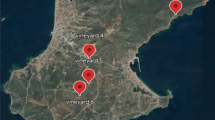Abstract
Grapefruit growers in the tropics require information about existing and new citrus cultivars with high productivity potential. The objective of this study was to determine the growth, yield, and fruit quality performance of seven pigmented and four white grapefruit cultivars under the dry tropic conditions of Colima, Mexico. The trees were budded on sour orange (Citrus aurantium L.) rootstock and planted at a distance of 8 × 4 m. ‘Oroblanco’ and ‘Marsh Gardner’ white-fleshed grapefruit cultivars and ‘Chandler’, a pink-fleshed pummelo, were the largest trees with the greatest height (5.0–5.6 m), canopy diameter (6.2–6.3 m), trunk diameter (21.9–23.3 cm), and canopy volume (109–123 m3). Lower height (4.3–4.8 m) and canopy volume (73–96 m3), but with similar canopy diameter to the previously mentioned cultivars, were recorded for the remaining pigmented cultivars. ‘Chandler’ pummelo and four pigmented grapefruit cultivars (‘Shambar’, ‘Río Red’, ‘Ray Ruby’, and ‘Redblush #3’) had yearly productions of 34.8, 34.9, 34.1, 32.7, and 30.6 ton ha−1, respectively. The most productive white grapefruit cultivar was ‘Marsh Gardner’ (30.5 ton ha−1). Grapefruit cultivars having the largest fruit size showed a higher inverse relationship between fruit weight and yield than those with small fruit. Most genotypes had higher values of fruit weight, juice content, and maturity index than those required by the local market. The most promising grapefruit cultivars based on their acceptable growth, yield superior to 30 ton ha−1, and acceptable fruit color were ‘Río Red’, ‘Shambar’, ‘Ray Ruby’, and ‘Redblush #3’.

Similar content being viewed by others
References
Barry GH, Veldman FJ (1996) Performance of nine grapefruit (Citrus paradisi Macf.) cultivars under hot, subtropical southern African conditions. Proc Int Soc Citriculture 1:113–115
Breedt HJ, Koekemoer PJJ (1996) Evaluation of rootstocks for grapefruit in South Africa. Proc Int Soc Citriculture 1:164–166
Camacho BSE (1981) Citrus culture in high altitude American tropics. Proc Int Soc Citriculture 1:321–325
Castle WS, Phillips RL (1980) Performance of ‘Marsh’ grapefruit and Valencia orange trees on eighteen rootstocks in a closely spaced planting. J Am Soc Hort Sci 105:496–499
Castle WS, Wutscher HK, Youtsey CO, Pelosi RP (1988) Citrumelos as rootstocks for Florida Citrus. Proc Fla State Hort Soc 101:28–33
Crescimanno FG, Deidda P, Fray AM (1981) Citrus rootstock trials in Sardinia: preliminary results on the performance of ten rootstocks for ‘Navel’ and ‘Valencia’ orange and for ‘Marsh’ grapefruit. Proc Int Soc Citriculture 1:119–123
da Graca JV, Sauls JW (2000) Texas citriculture––past and present. Proc Int Soc Citriculture 1:451
da Graca JV, Louzada ES, Sauls JW (2004) The origins of red pigmented grapefruits and the development of new varieties. Proc Int Soc Citriculture 1:369–374
Donadio LC, Banzatto DA, Sempionato OR, Enciso CR (1996) Grapefruit cultivar evaluation. Proc Int Soc Citriculture 1:207–209
Economides CV, Gregoriou C (1993) Growth yield and fruit quality of nucellar frost ‘Marsh’ grapefruit on fifteen rootstock in Cyprus. J Am Soc Hort Sci 118:326–329
FAO (2004) Citrus fruit and processing. Annual Statistics FAO. Vialle delle Terme di Caracalla, 0100, Roma, 39 pp
Hearn CJ (1986) Development of seedless grapefruit cultivars through budwood irradiation. J Am Soc Hort Sci 111:304–306
Hensz AR (1977) Mutation breeding and the development of the ‘Star Ruby’ grapefruit. Proc Int Soc Citriculture 1:282–285
Hodgson RW (1973) Horticultural varieties of citrus. In: Reuther W, Webber HJ, Batchelor L (eds) The citrus industry, vol 1. Div. Agric. Sci., University of California, Berkeley, pp 431–589
Human CF, Steenekamp PJ, Snyman CJ, Maritz JGJ (1996) Evaluation of grapefruit and Valencia cultivars in South Africa. Proc Int Soc Citriculture 1:231–233
Lai Z, Chunling C, Qinliang S, Sunhua H, Dogmei L, Jianmei C, Zhenguang C (2000) Pummelo (Citrus grandis Osbeck) germplasm in Funjian: an important production region. 2000 Int Soc Citriculture Congress. Orlando Florida, pp 124 (Program and Abstract)
Lins SQ, Zhang QY (2000) “Honyou”: a red color mutant of Pummelo. Proc Int Soc Citriculture 1:212 (abstract)
Pardo A, Martínez C, Betancourt M, Del Val I, Estévez-Sanchez I, López A, Proenza M (1992) Grapefruit from the Isle of youth. Proc Int Soc Citriculture 1:108–109
Ray R, Walheim L (1980) Citrus: how to select, grow and enjoy. Horticultural Publishing Co. Inc. 176 pp
Reuther W (1973) Climate and citrus behaviour. In: Reuther W, Webber HJ, Batchelor L (eds) The citrus industry, vol 3, Div. Agric. Sci., University of California, Berkeley, pp 280–337
Sagarpa (2006) Sistema de información agropecuaria de consulta. SIACON
Saunt J (1990) The grapefruit. In: Truman K (ed) Citrus varieties of the world. Sinclair International Limited, England, 128 pp
Sinclair WB (1972) The grapefruit physiology and products. University of California, Division of Agricultural Sciences, 600 pp
Soler AJ (1999) Reconocimiento de Variedades de Cítricos en Campo. Generalitat Valenciana. Conselleria de Agricultura, Pesca y Alimentación. 187 pp
Soost RK, Cameron JW (1980) ‘Oroblanco’, a triploid pummelo-grapefruit hybrid. HortScience 15:667–669
Soost RK, Cameron JW (1985) ‘Melogold’, a triploid pummelo-grapefruit hybrid. HortScience 20:1134–1135
Stover E, Pelosi R, Burton M, Ciliento S, Ritenour M (2004) Performance of ‘Oroblanco’ and ‘Melogold’ pummelo × grapefruit hybrids on nine rootstocks on calcareous, poorly drained soil. HortScience 39:28–32
Zaragoza S, Trenor I, Medina F, Alonso E (1984) Agronomical behaviour of seven commercial citrus varieties cultivated in Spain. Proc Int Soc Citriculture 1:83–88
Acknowledgment
The authors thank the Fundación Produce Colima who supported this research.
Author information
Authors and Affiliations
Corresponding author
Rights and permissions
About this article
Cite this article
Becerra-Rodríguez, S., Medina-Urrutia, V.M., Robles-González, M.M. et al. Performance of various grapefruit (Citrus paradisi Macf.) and pummelo (C. maxima Merr.) cultivars under the dry tropic conditions of Mexico. Euphytica 164, 27–36 (2008). https://doi.org/10.1007/s10681-007-9627-8
Received:
Accepted:
Published:
Issue Date:
DOI: https://doi.org/10.1007/s10681-007-9627-8




